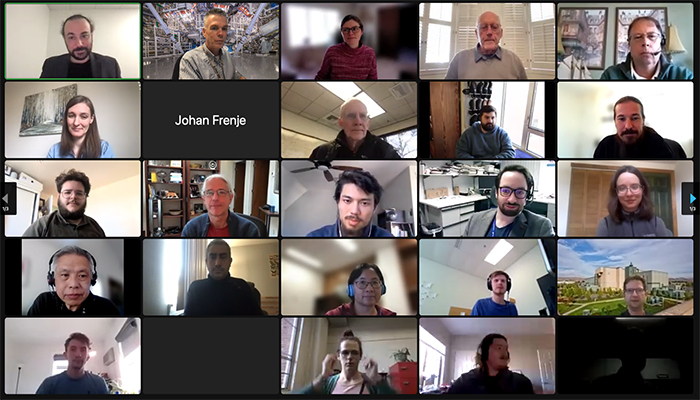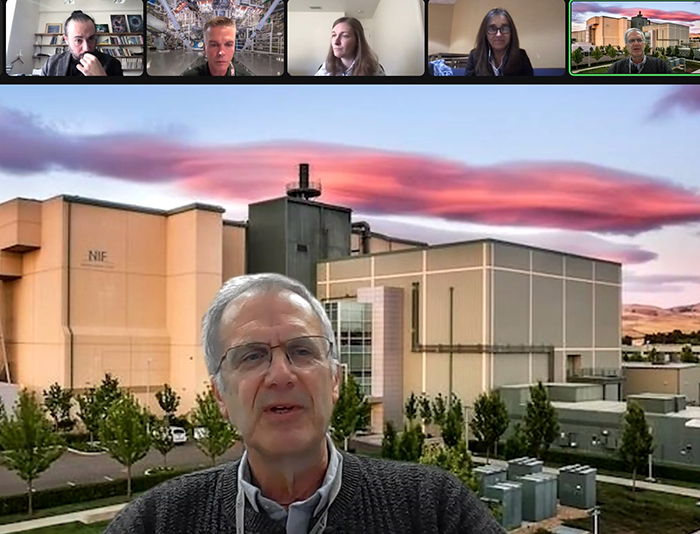NIF and JLF User Groups Cite HED Science Successes Amid Pandemic
March 15, 2022
 NIF and JLF Users Group attendees, including (top left corner) NIF User Group Chair Petros Tzeferacos, University of Rochester, NIF User Office Director Kevin Fournier, and (second row) JLF User Group Christine Krauland of General Atomics, gather virtually for the Feb. 7-9 annual meeting. The meeting was held online for the second consecutive year because of COVID-19 concerns. Credit: Kevin Fournier
NIF and JLF Users Group attendees, including (top left corner) NIF User Group Chair Petros Tzeferacos, University of Rochester, NIF User Office Director Kevin Fournier, and (second row) JLF User Group Christine Krauland of General Atomics, gather virtually for the Feb. 7-9 annual meeting. The meeting was held online for the second consecutive year because of COVID-19 concerns. Credit: Kevin Fournier Leaders of the National Ignition Facility and the Jupiter Laser Facility described high energy density (HED) scientific advancements in 2021—including NIF’s widely heralded 1.3-megajoule breakthrough in August—at the annual meeting of the NIF and JLF user groups.
The Feb. 7-9 meeting was held virtually via Zoom for the second consecutive year because of concerns related to the COVID-19 pandemic. A total of 229 people registered for the event, which brings together scientists and researchers from Lawrence Livermore National Laboratory (LLNL), academic institutions, other national laboratories, small companies, and federal sponsoring agencies. They have a common interest in science experiments at NIF, the world’s largest and most energetic laser, and the Janus, Titan, and COMET laser platforms operated by the Physical and Life Sciences Directorate’s JLF. The NIF User Office organized the virtual format on behalf of the user groups.
JLF’s progress in its four-year refurbishment plan was among the meeting’s highlights, and the groups learned more about currently running NIF Discovery Science Program campaigns and the newly selected campaigns to start in fiscal year 2023. Attendees were able to take a virtual NIF tour.
The scientific achievements of 2021, particularly coming amid the pandemic, were cited repeatedly at the user groups meeting.
“I really thank everyone for the enthusiasm and thank the community for the strong participation,” said NIF User Office Director Kevin Fournier, “showing that even in this strange time of returning to normal and emphasizing remote working and all the things we deal with now, we still have a very strong commitment to doing great science for the nation.” said
LLNL Director Kim Budil echoed Fournier’s comments, adding: “I think it’s a real testament to the commitment of the community that this has been the exciting year it has been for HED science writ large.
“I’m sure no one will ever get tired of talking about the progress of NIF and the inertial confinement fusion (ICF) program putting us squarely at the threshold of ignition,” Budil said. “But that’s just one small part of the work and the tremendous scientific program that’s been under way at the National Ignition Facility. Similarly, JLF is on this exciting path to increase its capabilities and become an integral part of LaserNetUS,” a national network of 10 ultra-powerful laser facilities.
Budil also praised the user community and its strong participation in the NIF Discovery Science Program as “an essential foundation to everything that we do.”
 NIF & Photon Science Principal Associate Director Jeff Wisoff addresses the NIF and JLF User Group Meeting and describes the 1.3-megajoule experiment on Aug. 8, 2021, on NIF.
NIF & Photon Science Principal Associate Director Jeff Wisoff addresses the NIF and JLF User Group Meeting and describes the 1.3-megajoule experiment on Aug. 8, 2021, on NIF. NIF & Photon Science Principal Associate Director Jeff Wisoff noted the positive psychological impacts of the 1.3-megajoule milestone. The record-setting Aug. 8, 2021, NIF experiment was the culmination of years of research and development in lasers, optics, diagnostics, target fabrication, experimental design, and computer modeling and simulation.
Those advances have brought researchers to the threshold of ignition, as defined by the National Academy of Science and the National Nuclear Security Administration (NNSA)—where a NIF implosion produces more fusion energy than the amount of laser energy delivered to the target. This result enables access to a new experimental regime for HED science and NNSA’s science-based Stockpile Stewardship Program.
“It’s really changed the way people think about what NIF is capable of doing, the timescale on which you can do it, and the importance of the HED field of study as a core science that’s really working on the edge of discovery,” Wisoff said. “I know that the recent result on NIF has brought the laboratory together. Everybody feels kind of a shot of motivation and excitement about the new level of performance.
“I notice the same thing when we do Discovery Science experiments that turn back some of the mystery of astrophysical objects or the Earth, that the same excitement is there, only in the case of the 1.3-MJ yield shot, the excitement is magnified many times over.”
NIF Director Doug Larson described 2021 as “an exciting year” for NIF, addressed the pandemic’s impact on the facility, and outlined the plan to address maintenance issues.
“I would say we’re doing pretty well, but would like to do even better,” Larson said, noting that well over 90 percent of NIF experiments meet scientific objectives but that the facility’s performance is lower than before the pandemic. Larson said the Lab’s COVID-19 protocols have been effective, but have impacted performance due to staffing issues when people are out sick or on quarantine.
He said NIF remains “the state-of-the-art facility more than 12 years in operation, but we are seeing some signs of degradation.” He noted factors contributing to declining output, such as an increase in the optics debris-induced damage that is limiting cumulative energy for programs, lost experimental time because of hardware failures, and degraded or unreliable systems contributing to a slow decline in the annual shot rate.
To address these issues, Larson said, NIF’s highest priority is implementing a plan to assure reliable operation for the next two decades. A five-year sustainability plan addresses deferred maintenance, obsolescence, and radiation hardness issues across NIF subsystems.
JLF Update
In her opening remarks, JLF User Group Chair Christine Krauland of General Atomics said JLF has been undergoing major renovations for the past few years, but is “looking forward to reopening for experiments for the user community later this year.”
JLF Director Bob Cauble and Operations Manager Brent Stuart gave an update on the four-year refurbishment plan, now in its final year.
Cauble said four overarching goals were established: returning JLF to full design energy and performance; Implementing improvements to increase the rate of high-energy shots; adding system and target area diagnostics to assess and monitor performance and provide relevant laser parameters to users; and, where possible and cost-effective, modernizing hardware and establishing equipment inventories.
He said the Department of Energy (DOE)’s Office of Fusion Energy Sciences has funded the addition of a third beamline that will be dedicated to Titan short-pulse (sub-picosecond) use.
The refurbishment and update of JLF has been “significantly delayed” by the pandemic, according to Cauble. He said completion is near and that a deadline for new experimental proposals was extended to March 20. Impacts have included major supplier problems, a low number of technical staff on site, unexpected sudden retirements, and the impact on crafts people (riggers, construction, electrical) across LLNL.
“Items crop up that you don’t expect like failed coatings for optics and equipment that’s delivered with the wrong software or firmware that has to be corrected,” he said.
A new system, a partnership with NIF, will be installed at JLF in late 2022 or early 2023, called Space-Time Induced Linearly Encoded Transcription for Temporal Optimization (STILETTO). It aims to mitigate laser-plasma instability via amplitude modulation. STILETTO is funded by LLNL for all users.
In addition, several improvements will be made to laser bay components and controls, including new deformable mirrors, shot request by computer entry, and automation of long-pulse shaping and alignment.
Poster Session Winners
General Atomics provided support for the meeting’s annual poster session. The poster contest winner in the postdoctoral category was Neel Kabadi of MIT for “Using the PTOF and WRF diagnostics to measure the D3He S-factor in ICF implosions.”
In the graduate student category, Cameron Allen of the University of Nevada, Reno, took first place for “Transport Property Experiments at OMEGA and NIF.” Second place went to Jonathan Willman of the University of South Florida for his poster, “Inelastic Shock Response of Diamond.”
This year’s Discovery Science projects span astrophysics, planetary science, particle acceleration hydrodynamics, and plasma physics.
The NIF and JLF members heard presentations from:
- Assaf Shimony, University of Michigan, on “Asymptotic Rayleigh-Taylor Instability Experiments on NIF.”
- Luke Ceurvorst, University of Rochester Laboratory for Laser Energetics, on “Observing the Effects of Ablation and Perforation on the Deeply Nonlinear Rayleigh-Taylor Instability.”
- Alexis Casner, University of Bordeaux, on “Calming Kelvin-Helmholtz Instability with a Strong, Pre-Imposed B-Field on NIF.”
- George Swadling, LLNL, on “Investigating Collisionless Shock Formation and Associated Particle Acceleration on the NIF.”
- Natsumi Iwata, Osaka University, on “Enhanced Proton Acceleration by Electron Confinement on the ARC Laser.”
- Erin Thornton, graduate student, University of North Texas/AFRL, on “Effects of Changing Pulse Length on Plasma Parameters and RF Generation of a USPL Driven Plasma Filament.”
- Alex Zylstra, LLNL, on “Using NIF Implosions to Study Electron Screening.”
—Jon Kawamoto
Follow us on Twitter: @lasers_llnl



